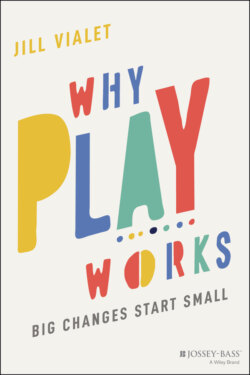Читать книгу Why Play Works - Jill Vialet - Страница 17
Time‐Out: Structured Versus Unstructured Play
ОглавлениеThe debate about the value of play—and more specifically the difference between play with rules and other forms of play—continues to this day, largely characterized as structured versus free play. Over the years, Playworks has been criticized for what was perceived as our emphasis on structured play. Although the free‐play folks haven't always been huge fans of Playworks, we generally feel quite warmly about free play. Peter Gray is a psychologist and professor at Boston College who has written extensively on the importance of “freedom to learn,” basically the idea that kids come into the world curious to learn and that this instinct drives them to play.11 The job of grown‐ups, in this framing, is to create environments that support children's innate curiosity and, as much as possible, to stay out of the way.
Professor Gray was originally introduced to Playworks by a reporter who was writing about our approach and looking for someone to offer a more critical, and ideally negative, analysis. When Playworks was described as a program that brought in recess coaches to coordinate student play at the break time, Peter was initially willing. It sounded, given the way that the reporter described it, like the ultimate infringement on students having choice and voice during the time in the school day that is often the last bastion of student control. When he actually learned more about our work with a visit to see our program in action at a school in Boston, however, it dramatically changed his understanding.
My view of Playworks was shaped by two observations. First, is the horrible observation that the recess length was only 15 minutes. This is a crime. It is not enough time for children to play. Given that, it seemed beneficial to have a young adult help get something started. I noticed that there was no requirement to participate and that the young Playworks person did a good job of stepping out and letting the kids take control once the game was started. I also learned from a friend (who was a math consultant visiting many schools in Boston) that the Playworks facilitator was typically the most popular person at school and was bringing a more playful attitude to everyone.
Watching Playworks coaches connect with students by creating a structure for play that the students could successfully navigate and ultimately control, emphasizing student volition, and ultimately protecting the time against school concerns about issues of safety, Peter came to see our work—although not his first choice—as nonetheless a necessary defense of play in schools.
UC Santa Cruz sociologist Rebecca London has spent much of the past 10 years studying recess, with a particular focus on Playworks. In her book, Rethinking Recess: Creating Safe and Inclusive Playtime for All Children in School, she offers that Playworks’ approach falls outside this debate by providing an alternative: organized play.
Recess, like any other time of the school day, requires some planning. My research findings demonstrate that schools can create a positive recess environment through planning and organization that is neither structured nor unstructured and that supports both physical activity and social and emotional growth. It is not a simple one‐size‐fits‐all approach, but rather a customized approach to recess planning and organization that requires firsthand knowledge of the school context and the students’ needs—information that all school administrators already have. Given the potential benefits and drawbacks of both structured and unstructured recess approaches, and the multiple ways that schools can support students to develop, this hybrid approach of organized recess makes the most sense and has been proven to be effective. 12
